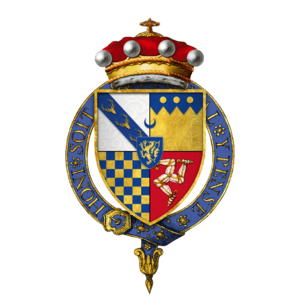Edward Stanley, 1st Baron Monteagle facts for kids
Edward Stanley, 1st Baron Monteagle (around 1460–1523) was an important English soldier. He later became a noble, known as a peer, and a special knight called a Knight of the Garter. He is best remembered for his brave actions at the Battle of Flodden.
Contents
Edward Stanley's Life Story
Early Life and Royal Connections
Edward Stanley was born around 1460. He was the fifth son of Thomas Stanley, 1st Earl of Derby. His mother was Eleanor, daughter of Richard Neville, 5th Earl of Salisbury.
He became a knight on August 24, 1482. This happened during the reign of King Edward IV. Richard, Duke of Gloucester, who later became King Richard III, knighted him at the capture of Berwick upon Tweed.
In 1483, Edward was one of the people who helped carry King Edward IV's coffin at his funeral. His father, Thomas Stanley, had married the mother of Henry of Richmond. This connection, and his father's help at the battle of Bosworth, made Henry VII favor the Stanley family when he became king.
Important Roles and Duties
In 1485, Edward became the High Sheriff of Lancashire for life. This meant he was in charge of law and order in that area. He was also asked to prepare for possible attacks from Scotland. He was given the job of looking after New Park in Langley. He also became a special knight who served the king directly.
In 1489, he was given control of several lands. These included Farleton in Lonsdale, Farleton in Westmoreland, and Brierley in Yorkshire.
The Battle of Flodden
In 1511, Edward helped organize soldiers in Yorkshire and Westmoreland. In 1513, he played a very important part in the battle of Flodden. This was a major battle against the Scottish army. Edward was paid a large sum of money for bringing his soldiers and paying them during this campaign.
Some old songs and stories say that the English army wanted Edward Stanley to lead the front of their forces. However, the main commander, Earl of Surrey, supposedly put him in the back. Even so, Edward Stanley fought very well. He helped force the Scottish soldiers off their strong position on a hill. Some stories even claim he personally killed James IV of Scotland, the Scottish king. The famous writer Walter Scott mentioned him in his poem Marmion with the line: 'Charge, Chester, charge—on, Stanley, on'.
Official reports do not confirm all these details. However, Thomas Ruthall, the Bishop of Durham, did say that Stanley fought bravely. He suggested that Edward should be made a noble for his great service.
Becoming a Baron and Later Life
Because of his actions, Edward Stanley was made a Knight of the Garter on May 8, 1514. This is a very high honor for a knight.
Six days later, he is said to have gone to Calais and fought against the French. On November 23, 1514, he was called to the House of Lords. This meant he became a noble with the title of Baron Monteagle.
In June 1520, he was present at the Field of the Cloth of Gold. This was a famous meeting between King Henry VIII of England and King Francis I of France.
Edward Stanley died on April 6, 1523. He was buried at Hornby, Lancashire, where his family owned Hornby Castle. He had also started a religious group there to remember his success at Flodden.
Edward Stanley's Family
Edward Stanley married twice.
His first wife was Anne Harrington. They did not have any children together.
He then married Elizabeth Vaughan. She was the daughter of Sir Thomas Vaughan of Tretower and the widow of John Grey, 8th Baron Grey de Wilton. With Elizabeth, he had one son:
- Thomas Stanley, 2nd Baron Monteagle: He became the 2nd Baron Monteagle after his father died in 1560.
- William Stanley, 3rd Baron Monteagle: William was the 3rd Baron. He died in 1581 without any sons. His daughter, Elizabeth, married Edward Parker, 12th Baron Morley. Their son, William Parker, later became the 4th Baron Monteagle and 13th Baron Morley.
Some believed that Thomas Stanley, who became a bishop during the English Reformation, was Edward's son from outside of marriage. He likely died in 1568 while still serving as a bishop.


